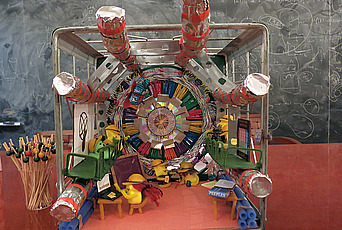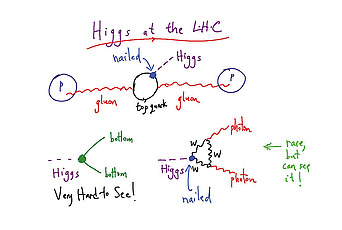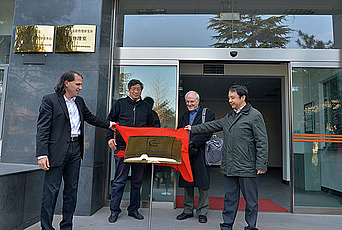In the public lecture “The World’s Largest Experiment,” Nathan Seiberg, Professor in the School of Natural Sciences, discusses the Large Hadron Collider (LHC) and the potential discoveries it may yield—among them, new insights about the origin of mass, the physics of the early universe, new symmetries of nature, and extra space dimensions—in addition to providing a better understanding of the Standard Model of particle physics, which describes the elementary particles and the forces acting between them. An article about his lecture appears below.
In the theory of particle physics known as the Standard Model, matter particles can be arranged in a periodic table much like in chemistry, according to School of Natural Sciences Professor Nathan Seiberg, with an important exception. In his October 4 lecture "The World's Largest Experiment," Seiberg explained that while there isn't a single experiment that contradicts the Standard Model, our current understanding of it is limited.
"We have this periodic table of matter particles but we don't understand the fundamental structure underlying it, which explains why we have this periodic table," said Seiberg. "In the case of chemistry, the periodic table was eventually understood as a consequence of the structure of atoms. We don't have the analogous story."
The Large Hadron Collider (LHC), a particle accelerator expected to begin operating this year, offers an opportunity to find "a more complete theory, which has a larger range of validity, a theory that will explain the Standard Model," Seiberg said.
Located at CERN, the European Center for Nuclear Research near Geneva, the LHC will allow for the exploration of physics at shorter distances and at higher energies than before. The accelerator, which cost about $2.5 billion, is located 100 meters underground and measures 17 miles around. Seiberg explained that in this underground tunnel two tubes of rotating protons will cross each other at four points. Detectors located at each of the crossing points will examine the debris left behind as the protons collide.
Overall, there will be about one billion proton collisions per second. "Only about 10 to 100 of the collisions will be of some interst to us and be recorded," said Seiberg. "The very interesting collisions, those collisions that will teach us about new physics, will be even more rare. They will happen once every few hours or every few days. So this is really finding a needle in a haystack."
Physicists are hoping that the LHC will help clarify some long-standing mysteries. Among them, said Seiberg, is proof of the existence of the Standard Model's Higgs particle, named after the Scottish physicist Peter Higgs, which has not yet been discovered experimentally. "The Higgs particle is very important because it is responsible for masses of particles," said Seiberg. "Understanding the Higgs particle better will shed more light and will clarify the origin of mass."
It is also hoped that the LHC will confirm the existence of supersymmetry, a theory that unites matter particles and force particles by pairing them in a single framework and suggests that the three forces in the Standard Model––the strong force, the weak force, and the electromagnetic force––become one force at very short distances.
The LHC may also find new particles that could explain the existence of dark matter in the universe. "Recent astronomical results tell us that only about one-sixth of the matter in the universe is in the form of particles we know of," said Seiberg. "Most of the matter in the universe is not the kind of matter that we know of in the Standard Model. In the context of supersymmetry, we can offer an explanation. Supersymmetry naturally leads to a new stable particle that can be identified as the dark matter."
In addition, the LHC might be able to detect the existence of additional space dimensions, beyond the currently known three dimensions. Ideally, the LHC may lead physicists to the "ultimate goal" proposed by string theory of unifying gravity (which is excluded in the Standard Model) with electromagnetism, the strong force, and the weak force. While emphasizing that "we don't know what the LHC will find," Seiberg anticipates, "the discoveries will be very exciting. They will set the agenda and stimulate scientific research for decades to come."——Kelly Devine Thomas, Editorial Director


